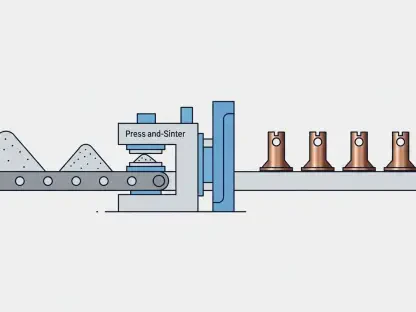In the ever-shifting landscape of the global semiconductor industry, Semiconductor Manufacturing International Corporation (SMIC) has emerged as a compelling case study of endurance with its Q2 2025 earnings report, released on August 10. Amid a backdrop of economic uncertainty, geopolitical friction, and a persistent slowdown in worldwide chip demand, SMIC’s ability to maintain financial stability while grappling with significant obstacles offers a glimpse into the complexities of operating as a key player in China’s tech ecosystem. The company’s performance reflects not just a battle against market volatility but also a strategic dance with domestic strengths and international limitations. As trade tensions between the U.S. and China continue to shape industry dynamics, SMIC stands at a crossroads, balancing robust cash reserves and strong domestic demand against technological barriers and margin pressures. This analysis delves into how the firm is navigating these turbulent waters, showcasing resilience while facing an uncertain path forward.
Financial Fortitude in a Tough Market
SMIC’s financial results for Q2 2025 underscore a remarkable capacity to withstand pressure, posting an EBITDA of $1.129 billion alongside a commendable 51.1% margin, even as revenue saw a slight 1.7% decline from the previous quarter. A high wafer fabrication utilization rate of 92.5%, driven largely by consistent demand within China, has been instrumental in keeping profitability intact. However, challenges are evident with gross margins slipping to 20.4%, a drop of 2.1 percentage points from Q1, primarily due to substantial depreciation costs that account for a significant portion of wafer pricing. Management’s outlook for Q3 signals further strain, anticipating EBITDA margins to compress to a range of 18–20%, a reflection of intensified pricing competition and the ongoing burden of capital investments. These figures highlight a company that, while financially sound, must navigate a narrowing path to sustain its bottom line amid external and internal cost pressures.
Beyond the headline numbers, SMIC’s financial narrative reveals deeper concerns about sustainability in a cyclical industry battered by global headwinds. The projected margin decline for Q3 2025 points to broader market dynamics, including an oversupply of chips and aggressive pricing strategies from competitors, which erode profitability even for established players. Additionally, the high depreciation costs tied to past and ongoing capital expenditures weigh heavily, signaling that the cost of maintaining or expanding production capacity could undermine short-term gains. Despite these challenges, SMIC’s ability to generate consistent revenue from a focused market segment in China offers a buffer that many global peers lack. For stakeholders, this duality of strength and vulnerability presents a complex picture—while the company’s earnings reflect operational discipline, the looming threat of squeezed margins in a volatile sector demands close attention to strategic adjustments in the coming quarters.
Capital Spending and Technological Barriers
SMIC’s aggressive investment strategy in Q2 2025, with $1.89 billion directed toward capital expenditures to ramp up 7nm production capacity to 30,000 wafers per month, demonstrates a clear intent to remain competitive in a technology-driven industry. The total capital outlay of $3.3 billion in the first half of the year underscores a commitment to bolstering infrastructure, a necessary move to meet domestic demand and maintain relevance in a market hungry for advanced chips. However, this heavy spending raises questions about return on investment, especially when geopolitical constraints limit the scope of technological advancement. U.S. export restrictions, particularly on EUV lithography tools essential for sub-7nm nodes, pose a formidable barrier, effectively capping SMIC’s ability to compete in cutting-edge segments like AI and high-performance computing. This technological ceiling casts a shadow over the long-term value of such substantial financial commitments.
The intersection of capital investment and geopolitical limitations creates a precarious situation for SMIC as it strives to balance growth with feasibility. While the push to enhance 7nm production aligns with immediate market needs, the inability to access tools for more advanced nodes means that these investments may only yield short-term benefits, leaving the company vulnerable to obsolescence in high-growth areas. Furthermore, the financial strain of such expenditures, coupled with uncertain global demand, amplifies the risk of overextension. Industry observers note that while SMIC’s focus on expanding capacity within its current technological boundaries is pragmatic, it also highlights a stark reality: without a resolution to international trade barriers or alternative innovation pathways, the firm’s trajectory in the global semiconductor race remains constrained. This dynamic underscores a broader challenge for chipmakers in geopolitically sensitive regions, where strategic spending must constantly adapt to external policy shifts.
Domestic Reliance: Strength and Risk Combined
A cornerstone of SMIC’s strategy has been its deep-rooted focus on the Chinese market, which accounts for an overwhelming 84.1% of its revenue in Q2 2025, providing a critical shield against global market fluctuations. Supported by government subsidies and a national drive toward technological self-sufficiency, this domestic orientation has mitigated losses from international demand drops, a point emphasized by CEO Zhao Haijun’s acknowledgment of effective contingency planning. In an era of U.S.-China trade tensions, this reliance on local clients and policies has allowed SMIC to maintain operational stability, leveraging state-backed initiatives to secure consistent orders. Yet, this approach is not without pitfalls, as it ties the company’s fortunes to a semiconductor ecosystem in China that is still maturing and occasionally driven by political rather than purely economic priorities.
While the domestic focus offers a safety net, it also introduces unique vulnerabilities that could impact SMIC’s resilience over time. Dependence on a single market, even one as vast as China, exposes the company to localized risks such as policy shifts, economic slowdowns within the region, or inefficiencies stemming from state-directed projects that may prioritize strategic goals over cost-effectiveness. Additionally, the still-developing nature of China’s semiconductor supply chain means that SMIC must often navigate gaps in infrastructure or expertise that global competitors might not face. This heavy reliance, while a buffer against international volatility, could become a double-edged sword if domestic demand falters or if government support wanes. For now, this strategy sustains SMIC’s operations, but diversifying revenue streams or strengthening global partnerships—despite geopolitical hurdles—may be essential to mitigate long-term exposure to regional uncertainties.
Investor Appeal Amid Sector Volatility
From an investment standpoint, SMIC positions itself as a defensive choice within the turbulent semiconductor sector, underpinned by a formidable $13.1 billion in cash reserves and a negative net debt-to-equity ratio of -3.4%, signaling strong financial health. Operational cash flow of $1.07 billion in Q2 2025 further reinforces this stability, offering a cushion against the industry’s inherent ups and downs. For investors seeking exposure to chipmakers without the high risk of growth-focused stocks, SMIC’s profile provides a margin of safety, especially as it projects a modest Q3 revenue growth of 5–7%. However, achieving this growth hinges on maintaining current high utilization rates, a challenge given the broader market’s inventory overhangs that could dampen demand and pressure pricing further in the near term.
Beyond its financial buffers, SMIC’s appeal to investors must be weighed against persistent structural challenges that temper enthusiasm for long-term growth. Geopolitical risks, particularly ongoing U.S. sanctions, continue to limit access to critical technologies, while margin erosion from rising costs and competitive pricing threatens profitability. These factors suggest that while SMIC offers a stable entry point into the semiconductor space, its potential for significant expansion remains constrained. Investors must also consider the company’s heavy domestic focus, which, while currently beneficial, could introduce volatility if China’s internal market dynamics shift. As a result, SMIC stands as a cautious bet—attractive for those prioritizing stability over aggressive returns, but requiring careful monitoring of external policy developments and internal cost management strategies to ensure sustained value over a 3–5 year horizon.
Future Hurdles and Strategic Considerations
Looking ahead, SMIC faces a landscape riddled with obstacles that could test its current resilience, starting with the unrelenting geopolitical pressures from U.S. sanctions that block access to advanced manufacturing tools. These restrictions not only hinder technological progress but also position the company at a disadvantage against global rivals in high-growth sectors like artificial intelligence and high-performance computing. Additionally, the ongoing margin compression, driven by escalating costs and competitive pricing, poses a threat to financial health if not addressed through efficiency gains or market repositioning. These challenges collectively suggest that while SMIC has navigated current storms adeptly, its ability to thrive in a rapidly evolving industry remains uncertain without significant breakthroughs in policy or innovation.
Strategically, SMIC must explore avenues to diversify its risk profile and bolster long-term competitiveness, even as it leans on domestic strengths. Efforts to forge partnerships or alternative technology solutions could alleviate some technological constraints, though such moves are complicated by international tensions. Meanwhile, optimizing capital expenditure to prioritize high-return projects and streamlining operational costs will be critical to counter margin pressures. As the semiconductor industry continues to grapple with cyclical volatility, SMIC’s path forward will likely depend on its agility in adapting to both market and geopolitical shifts. For stakeholders, the focus should be on tracking how the company balances these immediate imperatives with a vision for sustainable growth, ensuring it remains a viable player in a sector defined by relentless change and fierce competition.









